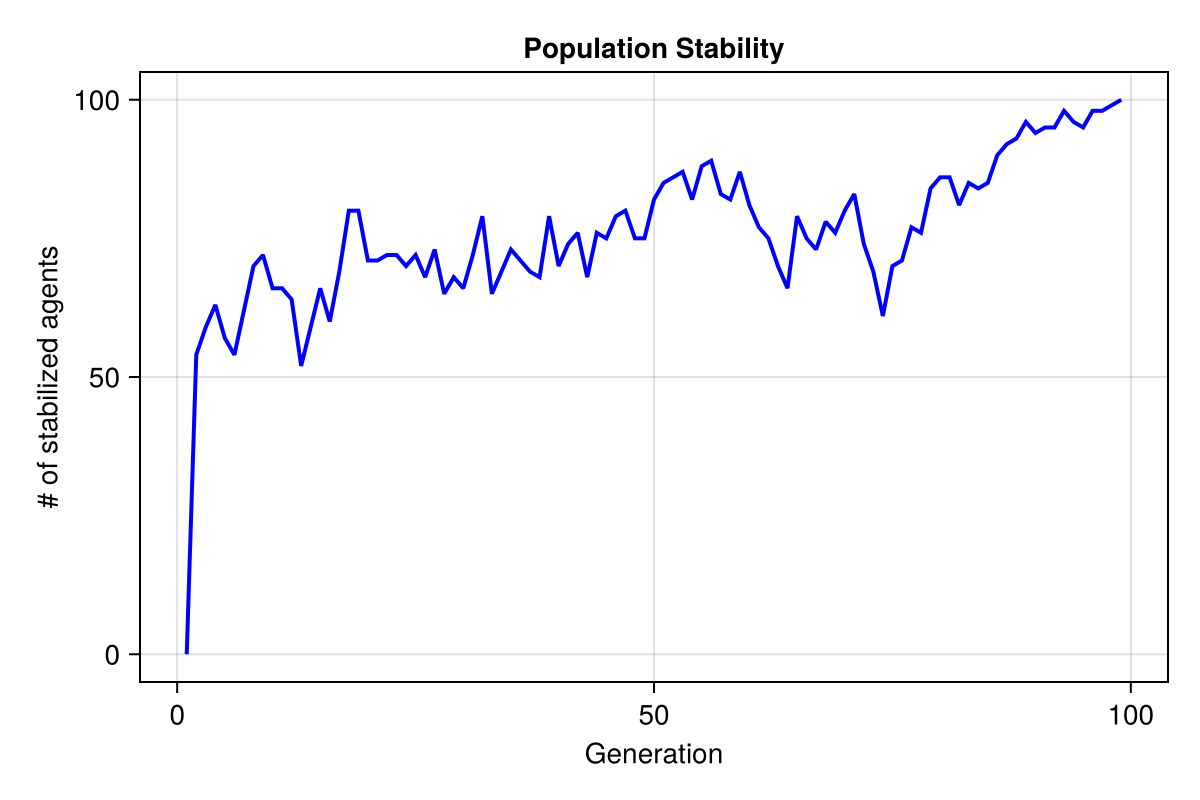Opinion spread
This is a simple model of how an opinion spreads through a community. Each individual has a number of opinions as a list of integers. They can change their opinion by changing the numbers in the list.
Agents can change their opinion at each step. They choose one of their neighbors Randomly(), and adopt one of the neighbor's opinions. They are more likely to adopt their neighbor's opinion if they share more opinions with each other.
Notice that just like the Forest fire and Conway's game of life examples this model is a Cellular Automaton: one agent exists per position and agents never move, or are killed/added after model creation. This means that a much more performant version can be done without any agents, but just matrices representing spatial properties just like in Conway's game of life. However, some users may find more this agent-based formulation more intuitive, and hence this example follows this approach.
using Agents
using CairoMakie # for static plotting
using Random
using StatsBaseModel creation
@agent struct Citizen(GridAgent{2})
stabilized::Bool
opinion::Array{Int,1}
prev_opinion::Array{Int,1}
end
function create_model(; dims = (10, 10), nopinions = 3, levels_per_opinion = 4, seed = 648)
space = GridSpace(dims)
properties = Dict(:nopinions => nopinions)
model = StandardABM(
Citizen,
space;
agent_step!,
scheduler = Schedulers.Randomly(),
properties = properties,
rng = MersenneTwister(seed),
)
for pos in positions(model)
opinion = sample(abmrng(model), 1:levels_per_opinion, nopinions, replace = false)
prev_opinion = sample(abmrng(model), 1:levels_per_opinion, nopinions, replace = false)
add_agent!(pos, model, false, opinion, prev_opinion)
end
return model
endcreate_model (generic function with 1 method)Stepping functions
function agent_step!(agent, model)
update_prev_opinion!(agent, model)
adopt!(agent, model)
stabilize!(agent)
end
function update_prev_opinion!(agent, model)
for i in 1:(model.nopinions)
agent.prev_opinion[i] = agent.opinion[i]
end
end
function adopt!(agent, model)
neighbor = sample(abmrng(model), collect(nearby_ids(agent, model))) # Randomly select a neighbor.
neighbor_opinions = model[neighbor].opinion # Look up neighbor's opinions.
agent_opinions = agent.opinion # Look up agent's opinions.
nmatches = length(intersect(neighbor_opinions, agent_opinions)) # Count how many opinions the neighbor and agent have in common.
if nmatches < model.nopinions && rand(abmrng(model)) < nmatches / model.nopinions
neighbor_opinion = sample(abmrng(model), setdiff(neighbor_opinions, agent_opinions)) # Find which opinions the neighbor has that the agent doesn't and Randomly() pick one for the agent to adopt.
agent_opinion = sample(abmrng(model), setdiff(agent_opinions, neighbor_opinions)) # Find which opinions the agent has that the neighbour doesn't and Randomly() pick one to change.
replace!(agent.opinion, agent_opinion => neighbor_opinion) # Replace agent's opinion with neighbor's opinion.
end
end
function stabilize!(agent)
if agent.prev_opinion == agent.opinion
agent.stabilized = true
else
agent.stabilized = false
end
endstabilize! (generic function with 1 method)Running the model
First, we create a stopping condition, which runs the model until all agents stabilize.
rununtil(model, s) = count(a -> a.stabilized, allagents(model)) == length(positions(model))rununtil (generic function with 1 method)Then we create our model, run it and collect some information
model = create_model(nopinions = 3, levels_per_opinion = 4)
agentdata, _ = run!(model, rununtil, adata = [(:stabilized, count)])(99×2 DataFrame
Row │ time count_stabilized
│ Int64 Int64
─────┼─────────────────────────
1 │ 0 0
2 │ 1 54
3 │ 2 59
4 │ 3 63
5 │ 4 57
6 │ 5 54
7 │ 6 62
8 │ 7 70
⋮ │ ⋮ ⋮
93 │ 92 98
94 │ 93 96
95 │ 94 95
96 │ 95 98
97 │ 96 98
98 │ 97 99
99 │ 98 100
84 rows omitted, 0×0 DataFrame)Plotting
The plot shows the number of stable agents, that is, number of agents whose opinions don't change from one step to the next. Note that the number of stable agents can fluctuate before the final convergence.
f = Figure(resolution = (600, 400))
ax =
f[1, 1] = Axis(
f,
xlabel = "Generation",
ylabel = "# of stabilized agents",
title = "Population Stability",
)
lines!(ax, 1:size(agentdata, 1), agentdata.count_stabilized, linewidth = 2, color = :blue)
f
Animation
Here is an animation that shows the stabilization of agent opinions over time.
ac(agent) = agent.stabilized == true ? :purple : :green
model = create_model(nopinions = 3, levels_per_opinion = 4)
abmvideo(
"opinion.mp4",
model;
agent_color = ac,
agent_marker = '■',
agent_size = 20,
framerate = 20,
frames = 60,
title = "Opinion Spread",
)